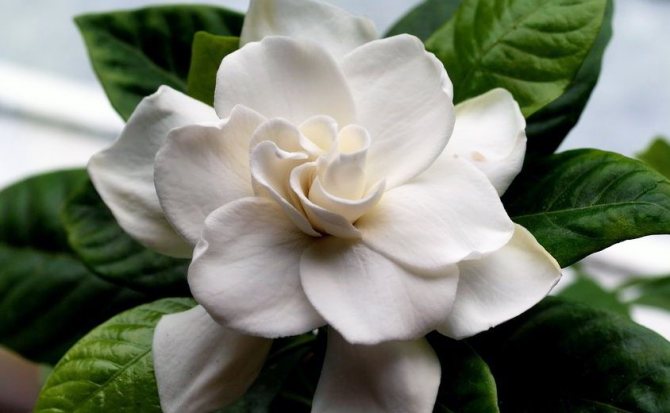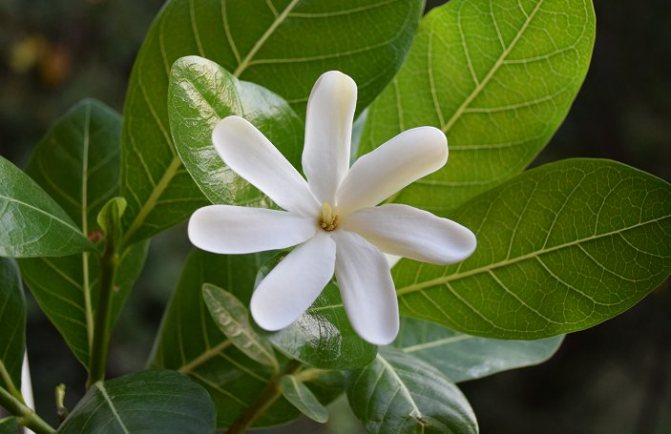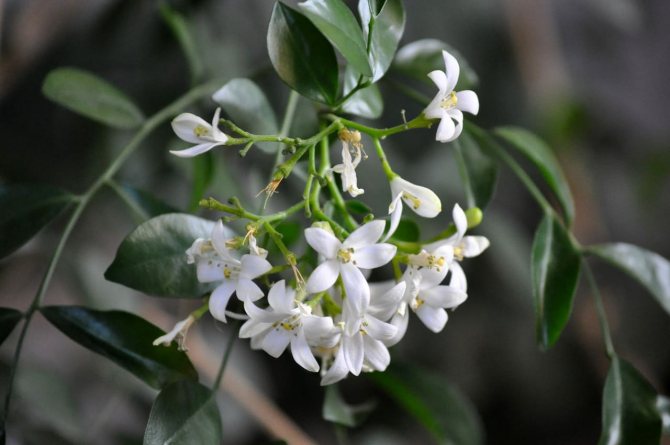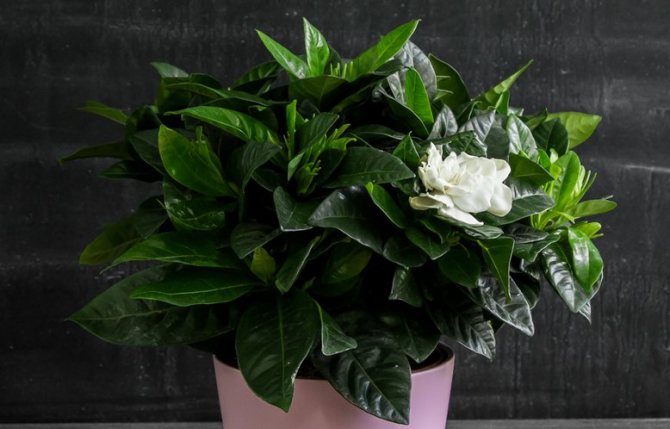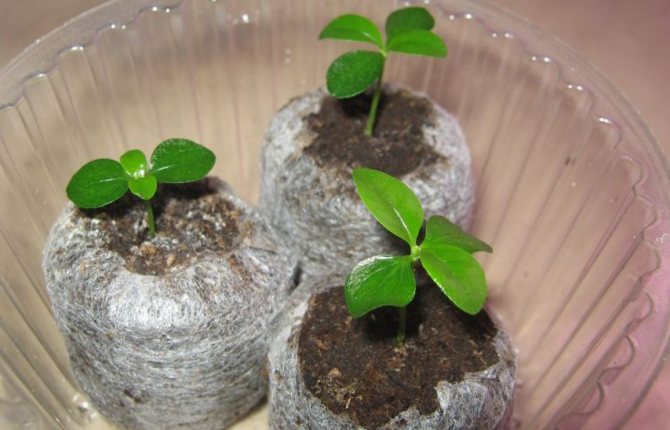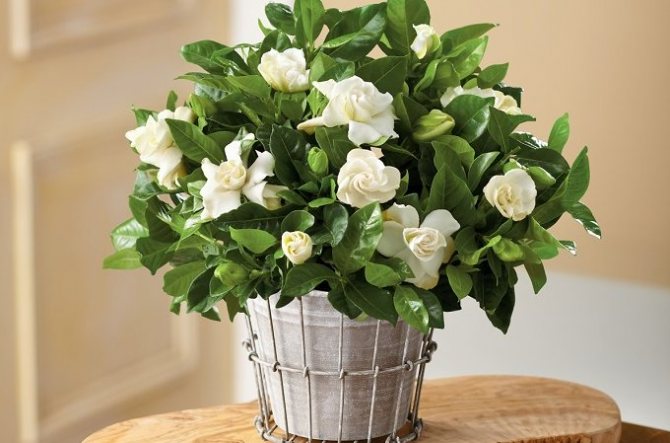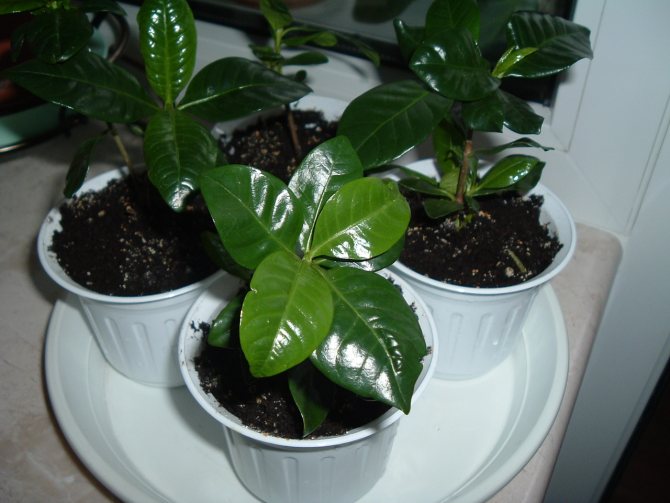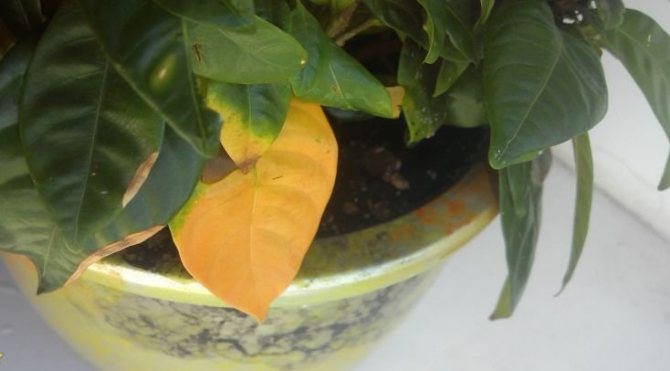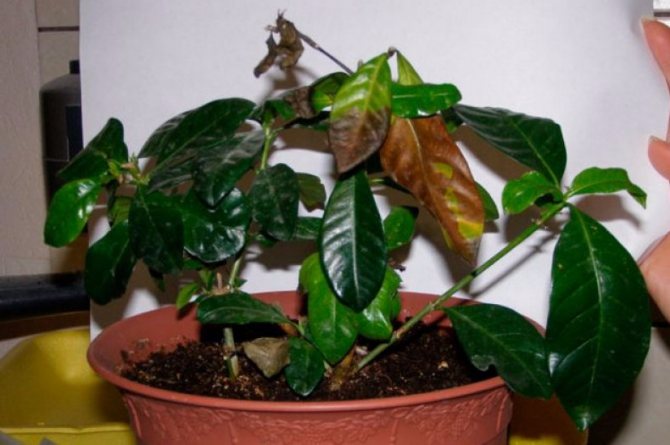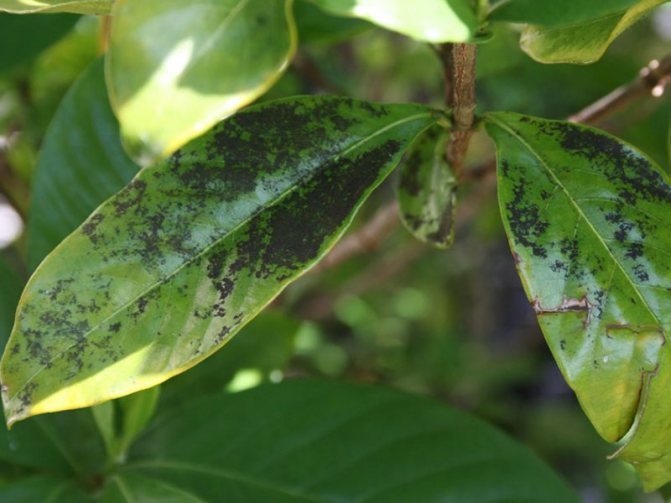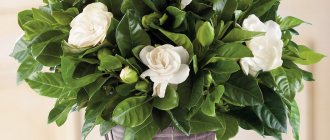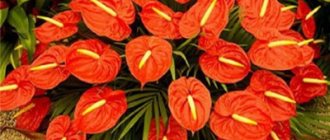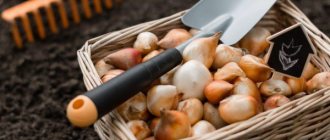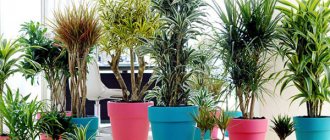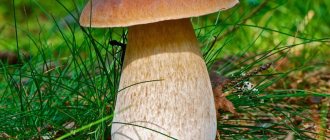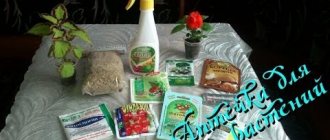Indoor gardenia is an evergreen shrub plant that grows up to one and a half meters. Natural conditions of gardenia are China and Japan. She has more than 250 varieties shrub and tree species.
It is curious: the name gardenia was given in honor of the famous American gardener A. Gorden.
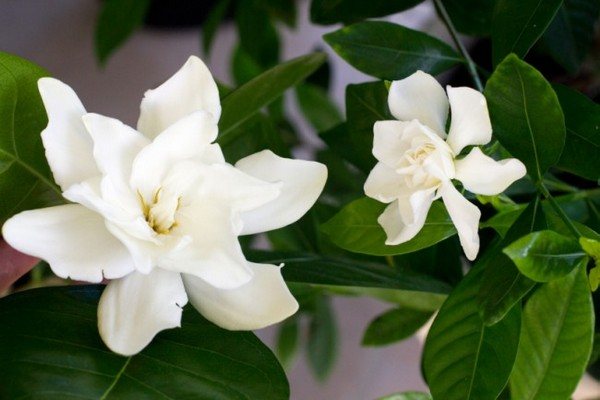
At home, shrub jasmine gardenia takes root well. The plant can be admired all year round. It has large shiny green leaves, branching stems, large flowers.
The flower is also called "Cape Jasmine" or "August" or "Gardenia regal"... It has a delicate white or cream color, simple or double inflorescences. The room where the plant lives is filled with a delicate jasmine scent.


Description
Gardenia jasmine, called Gardenia jasminoides in Latin, comes from the Madder family and is a native of India, China, Japan, Taiwan, Vietnam and the subtropics of Africa. In the bosom of nature, it can be found in the form of an evergreen flowering shrub up to 2 meters high. In a pot culture, the bush reaches no more than 60 cm in height.
In the genus Gardenia, there are about 250 species, and in indoor floriculture only the jasmine gardenia has taken root. Its large snow-white flowers with a delicate jasmine scent fascinate at first sight. They are located singly or are collected in inflorescences of several pieces. Most often, flowers are semi-double or double, similar to a beautiful rose.
Very decorative and dark green leaves. They are broadly lanceolate in shape with a pointed tip, reaching 10 cm in length. The sheet plate is distinguished by a relief surface that casts a glossy sheen.
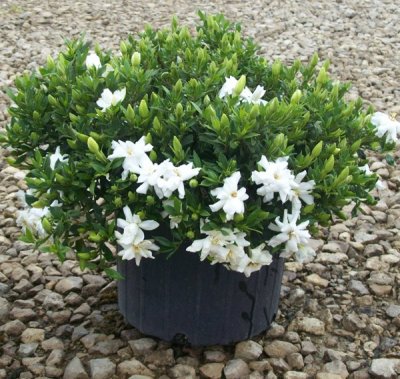

In general, indoor gardenia is a graceful bush with dense foliage, especially charming during the flowering period. With proper care, the life expectancy of a beautiful representative of the flora is up to 7 years.
Gardenia was introduced to Europe in the 18th century. In warm countries, she decorates gardens and parks, and in cool climates, it can only be kept at home or in a greenhouse. Through the efforts of breeders, many varieties of beauty have been bred.
Soil for germinating seeds of gardenia jasmine
Gardenia is rarely propagated by seed germination. This method is characterized by low productivity, since the seeds do not germinate for long. The composition of the soil for germinating seed material is somewhat different from the above.
The seeds are less susceptible to damage by pathogenic pathogens, therefore, charcoal is not added to the mixture. The looseness of the soil has a great influence on successful germination. This causes an increase in the proportion of sand.
The optimum mixture for germinating gardenia seeds and other indoor plants consists of:
- 50% peat crumb;
- 50% river sand.
It is important to ensure maximum uniformity of the composition in order to exclude obstacles to the sprouts and rudiments of the root system of germinating seeds.
Varieties
- Beauty or in Latin Beauty - perhaps the most popular variety with terry snow-white flowers. Blooms profusely from early June to autumn.
- Belmont, aka Belmont - differs with dense double flowers and is the most fragrant.Possesses increased resistance to diseases.
- Amy or Aimee - a bush with large flowers of an ideal double shape, reaching 12 cm in diameter. Able to bloom twice a year.
- Mystery or Latin Mystery Is a strong and hardy variety with large leaves, growing strictly vertically. The flowers are quite large, flat terry.
- Variegata, aka Variegata - variegated compact form with charming small flowers. In the color of the foliage, transitions from green to light cream are observed. It grows slowly and is ideal for growing in a pot.
- Radikans or Radicans - dwarf variety with small glossy leaves and small double flowers. This variety begins to bloom later than its congeners and is ideal for bonsai cultivation.
Features of home care for jasmine gardenia
Gardenia jasmine very moody and caring for her contains certain difficulties. She is sensitive to any changes in conditions by yellowing leaves and dropping buds. Success in growing a plant lies in strict adherence to all the requirements that it makes.
Lighting and temperature control
The gardenia beauty is a big lover of bright light, but not active sunlight. At noon, it is necessary to protect it from the active sun with a translucent curtain. Otherwise, burns will appear on the leaves. The best placement is a southwest or west window. Additional lighting will be needed on the northern windowsill.
The flower does not tolerate frequent movements, therefore it is very desirable to immediately give it a permanent place in the house.
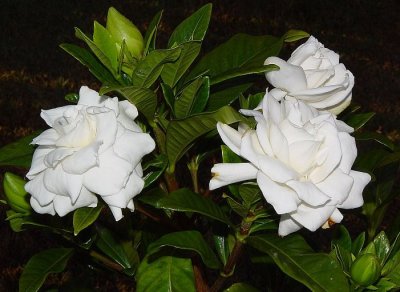

He especially does not like changes during flowering and can even shed the buds in response to a slight turn of the pot.
The optimum temperature for a plant in summer is from 21 to 24 ° C, in winter - within 16-18 ° C, reduction to 10 ° C is permissible.
In the winter months, coolness is very important for him, in which, in conditions of insufficient daylight, it is less depleted.
The beauty suffers greatly from drafts and temperature changes.
But she is especially afraid of hypothermia of the roots and can react to it by falling foliage and rotting roots. Therefore, you should not put the flowerpot with a green pet on a cold surface. In this case, some kind of elevation will help out.
Watering and humidity
Water your favorite flower sparingly. For him, both overdrying of an earthen coma and its waterlogging are very dangerous. In spring and summer, the land should always remain slightly damp, in winter it is allowed to dry out a little between waterings to a depth of 1.5 cm.
The water should be boiled, filtered from impurities and lukewarm. You should make it a rule to always drain it from the pallet after watering. It is useful to acidify the water with lemon juice (a few drops per liter). The plant assimilates many nutrients only in an acidic environment.
High humidity - another important condition for the health of a beauty. She loves daily spraying. In summer, water treatments should be especially frequent. The flowering bush should be sprayed carefully so that drops of moisture do not fall on the delicate petals. It does not hurt to place the tree on a tray with damp moss and place containers with water nearby.
Fertilization and feeding
From spring to autumn, the plant is fed every two weeks, alternating fertilizers for flowering and any organic. You can use azalea fertilizer. A couple of times per season, foliar dressing is carried out with preparations containing iron.
Dormant period


From October to February, the plant has a dormant period when it rests and gains strength. At this time, watering is reduced, and top dressing is canceled. Rest for the flower is very important so that it does not deplete and prepares itself for a new abundant bloom.
Bloom
The beautiful gardenia blooms from early summer to October. It prepares for flowering for a long time. When tying buds (March-April), the bush is moderately watered, protected from the bright sun, and the room is regularly ventilated (no drafts!). During this period, the correct temperature regime is especially important: at night - from 16 to 18 ° C, during the day - from 18 to 20 ° C.
With the appearance of buds, the most careful care is required. All conditions of detention are strictly observed. It is necessary to monitor the temperature, humidity, acidity of the earth, etc. For the slightest fault of the grower, a capricious beauty can throw off the buds. The flowering bush should not be rearranged and twisted around its axis, and the flowers should not be touched with your hands.
Each gardenia flower remains on the bush for about a week.
Interestingly, during this period, its snow-white color can change, becoming pale yellow or cream.
For many gardeners, especially beginners, the pet flatly refuses to bloom, for which there are many reasons. This may be insufficiently acidic soil, watering with hard water, dry air, poor lighting, lack or excess of nutrients, too low or too high temperature, and other violations of conditions. As you can see, only strict adherence to all the rules for care will make the beauty show herself in all her splendor.
Pruning
The effective shape of the bush is achieved by timely cutting. To obtain splendor in young specimens, pinch the elongated tops of the shoots. In older adults, weak branches are removed, and the remaining shoots are cut one third of the length.
To form a standard tree, side branches are removed and only the upper part is left. Upon reaching the desired height, pinch the upper point of growth and form a crown, cutting off excess shoots.
Transplant and soil composition
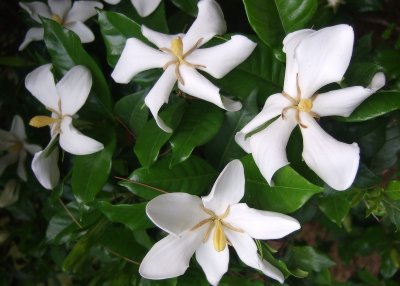

The flower rarely needs a transplant. It is necessary only if the pot has become too small, the roots have entwined the whole earth, or problems have arisen with them.
Repotting is best done in the spring or after flowering. Medium option - transshipment every 2-3 of the year.
The soil requires sour, loose and nutritious. A substrate for azaleas is fine. Or you can please a green friend with a self-prepared mixture of equal parts:
- Sod land
- Coniferous land
- Peat
- Coarse sand, vermiculite or perlite
Over time, such an acidic soil will leach out. Therefore, in the future, it is necessary to acidify it monthly with water with citric acid (a couple of drops per 1 l) and ferrous sulfate (0.5 g per 1 liter of water). Alternatively, you can use peat-infused water for irrigation.
Transfer after purchase
The newly acquired gardenia beauty cannot be transplanted. Wait two to three weeks and make sure the flowering is over. After this period, the flower is carefully removed from the pot (you need to tilt it down and, grabbing the base of the stem and shaking the bush, pull it out of the container). The next step is to clean the roots as thoroughly as possible from the transport soil, which is not too useful for them, and put the pet in a new container slightly larger than the previous one. A thick drainage layer is required at its bottom.
Choice of place and conditions of detention
A place
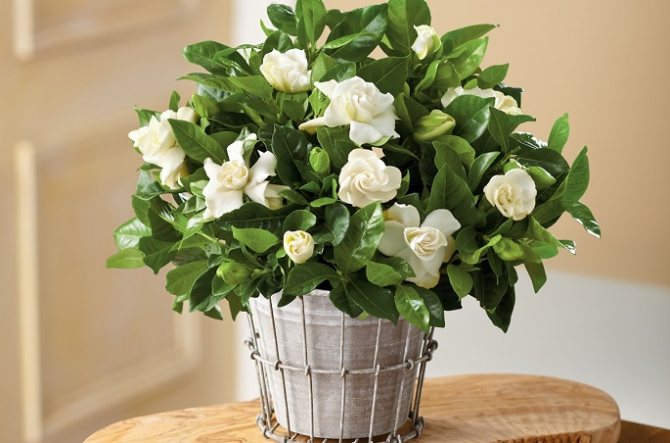

The place for the jasmine gardenia must be chosen permanent. She does not like permutations, and even turning the pot can lead to dropping of the buds. Since this plant is native to the subtropics, we must try to create appropriate conditions around it. The gardenia pot is best placed on the west, east, or southeast window.
Lighting
Lighting should be good, but diffused, direct sunlight can cause leaf burns.If the windows in the apartment face only south, then it is necessary to apply a sun curtain, if to the north - install an additional source of diffused light in the form of a fluorescent or LED lamp.
Temperature regime
The temperature regime must be strictly observed. The plant feels most comfortable at a temperature of 22 degrees, while an increase up to 24 degrees is possible during the day, and a decrease to 16 degrees at night.
In winter, at a temperature of 16-18 degrees, there is a massive formation of buds, but if the temperature is higher, then the plant will direct its forces to the growth of new branches. Drafts and hypothermia of the roots are unacceptable. It is advisable to substitute polystyrene under the pot so that in winter the roots do not freeze from the cold windowsill.
Humidity
Humidity should be high, but not excessive. 3 times a day, the air around the pot with the plant is sprayed so that water does not get on the leaves, otherwise they will be covered with ugly brown spots, and the buds may fall off.
You can put the pot on a pallet with expanded clay and water, but care must be taken that the bottom of the pot does not touch the water, excess moisture can ruin the roots. A vaporizer or just an aquarium next to the pot will help to maintain the desired humidity.
Priming
The soil for gardenia jasmine should be loose, with sand and perlite to better retain moisture. In specialized stores, you can buy an acidified soil mixture based on heather and peat-coniferous soil.
Reproduction
- Stem cuttings. In spring or autumn, apical cuttings about 10 cm long are cut from the bush. The top 3-4 leaves are left, the rest are removed. The cuttings are dipped for a few minutes in Kornevin, then planted in a peat-sand mixture, sprayed and covered with a film, not forgetting to regularly water and ventilate. The cuttings take root after about a month, after which they are transplanted into a suitable soil. Rooting is faster if bottom heating is used.
- Seedsthat can be collected from your own bush or purchased in the store. It is desirable that they are fresh - the old ones have a very low germination rate. Sowing is carried out in early spring. The seeds are soaked for a day, and then sown in a peat-sand mixture to a depth of no more than 5 mm. The container with crops is covered with foil or glass and placed in a warm place. with a temperature not lower than 25 ° C. With regular spraying and airing, the first shoots can be expected in a month. A plant grown from seeds will bloom only after a couple of years.
A gardenia grown independently from seed is less capricious, familiar to indoor conditions and is in good health.
How to check the acidity level of the soil
The acidity level of the soil must be indicated on the packaging of the soil mixture. The optimum acidity for jasmine gardenia does not exceed five units. A substrate with a pH of 4.5-5.5 is perfect for planting gardenia. Having a litmus test, you can independently check the acidity of the soil.


In addition, for simple manipulation, you will need:
- Free flowerpot with drainage layer and pallet. One or two handfuls of the finished substrate are poured into a flowerpot or other container and watered abundantly. For research, you will need water that has flowed into the pan;
- Or a glass container with high walls. In the case of a glass container, the earth is poured with an equal amount of water, mixed thoroughly and waited for the water to separate from the soil. The water is drained for research.
For the study, a substrate containing all the components is used, ready for planting a houseplant. Additional ingredients can affect the pH value.
Diseases
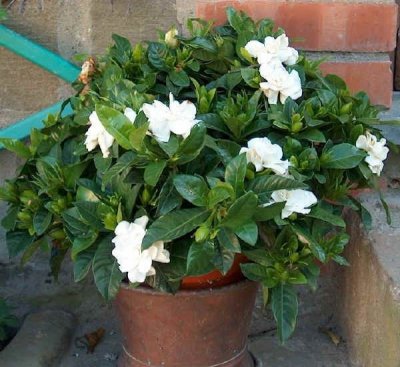

When growing gardenia jasmine, growers face many problems. The most common ones are:
- Why leaves turn yellow. Most likely the reason is temperature drops, improper watering or increased soil acidity. The adjusted temperature regime and proper watering will help to correct the situation. The addition of iron chelate to the soil will help reduce the acidity of the soil.
- Leaves turn yellow and fall. This problem can appear from a lack of light, inadequate nutrition, overdrying or waterlogging of an earthen coma. In this case, you need to place the bush in a well-lit place with light shading, feed with fertilizer for azaleas and establish proper watering.
- Why do the leaves turn black. The reason lies in excessive watering or getting sunburn. The flooded plant must be transplanted. In case of burns, remove all damaged leaves and put the bush in the shade for a while.
- Leaves and buds turn black and fall. This can occur from waterlogging, decay of roots, improper temperature and light conditions. In this case, you need to establish proper care and adhere to the recommendations described above. A heavily damaged specimen is transplanted into fresh soil, removing all diseased parts. The buds can turn black if sprinkled inadvertently. It should not be forgotten that they suffer greatly from the ingress of moisture droplets.
- Leaves are falling. If the leaves turn sharply yellow or fall off still green, then the flower has received serious stress in the form of drafts or "drought" in the pot. You should put it away from an open window or balcony door, adjust the watering and conduct a course of spraying with Epin.
How to prepare gardenia soil yourself
Many growers prefer to independently harvest various ingredients for planting indoor plants. Any city dweller can acquire a supply of sod and deciduous soil. To do this, it is enough to choose a suitable place in the park area. Areas along highways and agricultural land should be excluded. Garden and vegetable garden land is also not suitable.
You cannot harvest soil near oak, willow, willow, since they contain tannins.
To plant the jasmine gardenia you will need:
- Sod soil, which is collected in open areas free from trees and shrubs. The place should be well lit, not susceptible to waterlogging. The presence of wormholes is a good sign. By the way, sod soil is sometimes called "mole". It is believed that it is best to take it from earthen mounds that form near burrows;
- Coniferous land, accordingly, it is collected under coniferous trees. It is best if it is pine. Spruce plantings are poorly lit. It is necessary to remove the top layer of needles in order to prepare this type of soil. Coniferous soil has a characteristic composition and a high PH value;
- Leafy soil harvested in parks, forest plantations. Pay attention to the condition and type of trees. It is better to choose a site with young, actively growing deciduous trees. The soil under old trees contains less nutrients;
- Peat land sand, vermiculite are bought in the trade network. Choose high moor peat, which is most suitable for gardenia. It can also be found in elevated areas near old reservoirs with overgrown banks. Peat improves soil porosity.
In addition, drainage material will be required. It is best to use medium-sized expanded clay. Shards, brick chips, polystyrene, gravel are not suitable for gardenias due to their properties and mineral composition. Expanded clay must be subjected to preliminary preparation, similar to the preparation of sand. Only roasting in the oven is excluded. The boiling time is increased to 30 minutes in order to completely free the expanded clay pores from salts.
The drainage mixture should occupy at least a quarter of the flowerpot space.Its amount is increased to a third of the pot if young plants with a small root system are planted.
The roots of the jasmine gardenia must not come into contact with the drainage layer.
Pests
Dangerous for a beauty:
- Shield
- Spider mite
- Aphid
Pest control is carried out using insecticides. Two or three treatments are carried out with an interval of 7-8 days until the insects are completely destroyed. Pest prevention - regular inspection of foliage, maintaining sufficient moisture, keeping the bush clean.
Needless to say, caring for jasmine gardenia requires a lot of strength, patience and diligence. But the work will not be in vain. In response to attention and care, the green pet will certainly present you with a luxurious bouquet of breathtaking beauty.
Photo
Next, you will see a photo of diseases and home care for the Gardenia jasmine flower:



